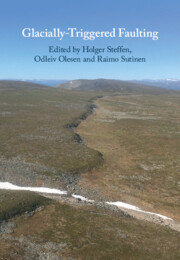Book contents
- Glacially-Triggered Faulting
- Glacially-Triggered Faulting
- Copyright page
- Contents
- Figures
- Tables
- Contributors
- Preface
- Part I Introduction
- Part II Methods and Techniques for Fault Identification and Dating
- Part III Glacially Triggered Faulting in the Fennoscandian Shield
- Part IV Glacially Triggered Faulting at the Edge and in the Periphery of the Fennoscandian Shield
- Part V Glacially Triggered Faulting Outside Europe
- Part VI Modelling of Glacially Induced Faults and Stress
- Part VII Outlook
- Index
- References
Part IV - Glacially Triggered Faulting at the Edge and in the Periphery of the Fennoscandian Shield
Published online by Cambridge University Press: 02 December 2021
- Glacially-Triggered Faulting
- Glacially-Triggered Faulting
- Copyright page
- Contents
- Figures
- Tables
- Contributors
- Preface
- Part I Introduction
- Part II Methods and Techniques for Fault Identification and Dating
- Part III Glacially Triggered Faulting in the Fennoscandian Shield
- Part IV Glacially Triggered Faulting at the Edge and in the Periphery of the Fennoscandian Shield
- Part V Glacially Triggered Faulting Outside Europe
- Part VI Modelling of Glacially Induced Faults and Stress
- Part VII Outlook
- Index
- References
Summary
Geological investigations in the last decade increased the number of locations with evidence or indications for glacially triggered faulting in northern central and northeastern Europe, i.e. in the countries of Denmark, Germany, Poland, Belarus, Lithuania, Latvia, Estonia and parts of western Russia. These locations are at the periphery, the edge or even outside of the former ice margin. They are summarized in the following sections.
- Type
- Chapter
- Information
- Glacially-Triggered Faulting , pp. 261 - 338Publisher: Cambridge University PressPrint publication year: 2021



